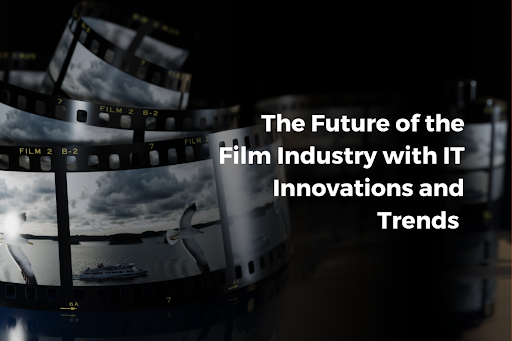
The Future of the Film Industry with IT Innovations and Trends
The film industry is one of the most creative and dynamic sectors in the world, constantly evolving and adapting to new technologies and consumer preferences. In recent years, the film industry has witnessed a surge of IT innovations and trends that have transformed the way films are produced, distributed, and consumed. These innovations and trends have also opened up new opportunities and challenges for filmmakers, film studios, and film audiences.
In this article, we will explore some of the IT innovations and trends that are shaping the future of the film industry, and how they are impacting the various aspects of filmmaking and film consumption.
IT Innovations and Trends in Film Production
One of the most significant IT innovations and trends in film production is the use of artificial intelligence (AI) and machine learning (ML) to assist filmmakers in various stages of the filmmaking process. AI and ML can help filmmakers with tasks such as script writing, storyboarding, casting, editing, sound design, visual effects, and more. For example, AI can generate realistic dialogues, characters, and plots based on the genre, theme, and style of the film. ML can analyze the performance and preferences of actors and actresses and suggest the best fit for each role. AI can also create stunning visual effects and animations, such as realistic facial expressions, movements, and environments, using techniques such as deepfakes, generative adversarial networks (GANs), and neural style transfer.
Another IT innovation and trend in film production is the use of cloud computing and blockchain to enable decentralized and collaborative filmmaking. Cloud computing allows filmmakers to access and share large amounts of data and resources, such as scripts, footage, and software, from anywhere and anytime, without the need for expensive and bulky hardware and infrastructure. Blockchain provides a secure and transparent platform for filmmakers to manage and track the ownership, rights, and royalties of their films, as well as to raise funds and distribute profits among the stakeholders. Blockchain can also facilitate peer-to-peer distribution and consumption of films, bypassing the intermediaries and fees of traditional platforms.
IT Innovations and Trends in Film Distribution
One of the most prominent IT innovations and trends in film distribution is the rise of streaming platforms and video-on-demand (VOD) services, such as Netflix, Amazon Prime Video, Disney+, and HBO Max. These platforms and services offer a wide range of films and shows, from mainstream blockbusters to niche indie films, to cater to the diverse and personalized tastes and preferences of film audiences. They also provide a convenient and flexible way for film audiences to access and watch films, anytime and anywhere, on various devices, such as smartphones, tablets, laptops, and smart TVs. Streaming platforms and VOD services also enable filmmakers and film studios to reach a global and massive audience, without the limitations and costs of theatrical releases and physical media.
Another IT innovation and trend in film distribution is the use of social media and influencer marketing to promote and generate buzz for films. Social media platforms, such as Facebook, Twitter, Instagram, and TikTok, allow filmmakers and film studios to interact and engage with film audiences, and to create and share content, such as trailers, posters, behind-the-scenes, and user-generated content, to build anticipation and excitement for films. Influencer marketing involves collaborating with influencers, such as celebrities, bloggers, vloggers, and podcasters, who have a large and loyal following on social media, to endorse and recommend films to their fans and followers. Social media and influencer marketing can help filmmakers and film studios to increase the awareness and visibility of their films and to influence the opinions and behaviors of the film audiences.
IT Innovations and Trends in Film Consumption
One of the most exciting IT innovations and trends in film consumption is the emergence of immersive and interactive film experiences, such as virtual reality (VR), augmented reality (AR), and mixed reality (MR). These technologies allow the film audiences to experience films more realistically and engagingly, by creating and enhancing the sensory and emotional aspects of the film. For example, VR can transport the film audiences to the film world and allow them to explore and interact with the film characters and environment. AR can overlay the film elements onto the real world and allow the film audiences to experience the film in their surroundings. MR can blend the film elements and the real world and allow the film audiences to manipulate and influence the film outcome.
Another IT innovation and trend in film consumption is the growth of user-generated and participatory film content, such as fan films, remixes, mashups, and parodies. These types of film content are created and shared by the film audiences, using various tools and platforms, such as YouTube, TikTok, and Twitch. They reflect the creativity and passion of the film audiences and their interpretations and expressions of the film. They also foster a sense of community and belonging among the film audiences, who can communicate and collaborate, with the filmmakers and film studios, through comments, feedback, and ratings.
The Future of the Film Industry with IT Innovations and Trends
The film industry is undergoing a rapid and radical transformation, thanks to the IT innovations and trends that are reshaping film production, distribution, and consumption. These innovations and trends are creating new possibilities and opportunities for filmmakers, film studios, and film audiences, as well as new challenges and risks. As Paulina Arredondo, the marketing manager of Global Triangles, industry, says:
“The future of the film industry is bright and exciting, with IT innovations and trends that are enhancing the quality, diversity, and accessibility of films. However, the future of the film industry is also uncertain and complex, with IT innovations and trends that are disrupting the traditional models and practices of films. The film industry needs to embrace and adapt to these changes, and to balance the benefits and drawbacks of IT innovations and trends, to thrive and survive in the competitive and dynamic film market.”
As film lovers and enthusiasts, we can also look forward to the future of the film industry with IT innovations and trends and enjoy the amazing and diverse film experiences that they offer. As Charles H. Davis, a renowned film scholar and critic, writes:
“Documentaries serve the audience’s need for information, learning, factual programming, and entertainment, and also raise serious issues for public consideration and action (Aufderheide, 2005).”
The same can be said for all types of films, as they are not only a source of entertainment, but also a medium of education, inspiration, and social change. IT innovations and trends can help films to fulfill these roles, and to enrich our lives and society.







